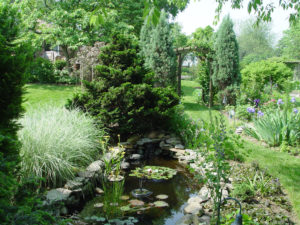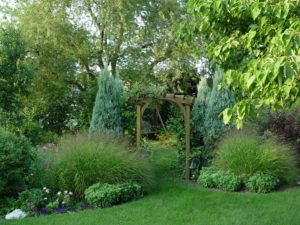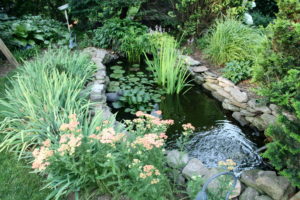A Garden Sanctuary
April 26th, 2022
Soon after my daughter – then a junior in high school – left for a year-long exchange program living in the Netherlands, I found myself spending a lot of time in a particular corner of my back yard.

This was my early garden sanctuary view from a swing under a big black-cherry tree.
I’d go back to this shaded far corner under a wild black cherry tree and think about what Erin might be doing… counting the days until her return, and above all else, praying that she was safe. (It’s what worry-wart dads do.)
A few years later, when my trigeminal neuralgia face pain returned, I again found myself heading back to that little corner. I’d try to figure out what I was going to do next while attempting to distract the pain with the sound of my water garden.
I purposely built a garden back there as a get-away – a place mainly to enjoy some quiet time away from the phone and computer.
What I didn’t realize is that this space had become my garden sanctuary.
That phrase didn’t ring a bell until I read a blog post last month by a western-Canada Master Gardener and author named Stephanie Rose.
Stephanie runs an amazing website and blog called “Garden Therapy” that bloomed in the aftermath of her nine-year-long bout with severe headaches and crippling fatigue.
Her coping efforts mirrored mine as she discovered how healing that one, special, tiny space of nature can be.
“I would argue there isn’t a better recovery program in the world!” she writes of her garden sanctuary.
For Stephanie, her space was a hammock chair under a deck, surrounded by flowers and plants.
“Whenever I needed a moment outside but didn’t have the energy, I could sit and sway in the chair and still be among the plants,” she says. “Without my garden, I don’t even want to know what I would have done while dealing with my debilitating illness.”
Stephanie found out first-hand what a trove of medical research has substantiated – that gardens can be therapeutic places.
I think lots of others have figured that out, too, lately. After two years of COVID hideout, so many people have mentioned their gardens as tranquil retreats of peace, fresh air, and sanity.
Sometimes, garden sanctuaries occur naturally (maybe with the simple addition of a bench) or take shape organically. But most of the time, they take a little planning to create.

This arbor served as the doorway into my garden sanctuary. Note you can’t even see back there.
In my case, I already had a mature black cherry tree just off the back right corner of my third-of-an-acre suburban lot in Hampden Twp. But that was it.
The first thing I did was plant a viburnum, a blue holly, and three arborvitae to create some privacy in the understory of that corner.
Then I added an A-frame garden swing under the tree, lined off a curving grass path to get through the yard to it, and built a pair of gardens flanking the path.
I put an arbor at the entrance to the path to serve as a sort of doorway from the “hectic” space into the “get-away” space. I softened the arbor with native honeysuckle vines and flanked it with upright junipers to create an evergreen wall – both for more privacy and to keep the arbor from being a door hanging out there without a wall.
The final piece was digging a kidney-shaped water garden that I could view from the swing. It was out just enough from the cherry-tree canopy to take in sunlight for blooming waterlilies while the swing itself was completely in the shade.
It was perfect.

Water is a really nice addition to any garden sanctuary. This was my pond.
Because of the screening and the curved path, you couldn’t even see the water garden or most of this secret little garden from the back of the house.
Then we moved.
Part of the sales contract was the stipulation that I fill in the water garden, so this special space is no more.
I’ve dug and planted lots of gardens at my new place in the Pittsburgh suburbs, but I haven’t created what I’d call a garden sanctuary. The gears are turning, though.
Stephanie’s blog post offers some additional thoughts on how to create a garden sanctuary.
“The first thing you want to do is find the perfect spot,” she says. “When surveying the yard, note if you have any favorite parts that you already gravitate to. Can you improve it in any way?”
If not, she suggests looking for areas with “untapped potential. Perhaps there’s an area of the garden that’s gone neglected that could be a diamond in the rough.”
One nice feature of a sanctuary is that it doesn’t have to be big. In fact, a small, secluded cove that won’t take much work or money to build might be even better.
“As long as you create an outdoor space you see yourself spending time in, that’s all that matters,” says Stephanie.
If the space isn’t already planted, Stephanie suggests making a list of your favorite plants and picking enough of them so there’s something going on for year-round interest.
“Sometimes it can help to have a general theme for your sanctuary,” she says. “It could be an herb garden full of aromatherapy favorites, a Mediterranean garden that reminds you of a favorite holiday, or perhaps a cottage garden full of wildflowers. A theme can help you narrow down your plants, but you can grow whatever you love most.”
A must-have feature is a comfortable place to sit.

Sometimes I’d even lay down on my A-frame swing.
For Stephanie, it was a hammock chair. I loved the A-frame swing. Others might lean toward an Adirondack chair or a rustic bench or a patio-furniture set.
Whatever works for you and your budget is right.
“For ambiance, don’t underestimate the power of outdoor lighting,” Stephanie says. “That lets you enjoy your space long after the sun has gone down.”
Also useful are container plantings for changeable color and fragrance, and as I found, some sort of water source – especially one that produces the soothing sound of trickling water.
For me, it was the water garden with a single small stone ledge that let water spill off the edge.
For Stephanie, it was a small plug-in fountain.
“The sound of water always has a calming effect,” she says, adding that water is a draw for wildlife such as birds, bees, butterflies, and hummingbirds.
But probably most important of all, Stephanie says, is to “make your space uniquely you.”
Stephanie’s website is loaded with ideas and instructions on more than 1,000 DIY projects that involve using plants as garden therapy.
They range from crafty ideas like making coasters from branch prunings and making greeting cards from pressed flowers to in-the-garden accessories like hypertufa ornaments and living-wall succulent gardens.
She’s also written 10 books, the newest of which is the “The Regenerative Garden” (Cool Springs Press, 2022, $24.99), which focuses mainly on growing food and nurturing plants by taking cues from nature.







